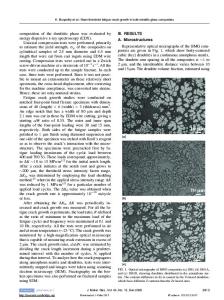Fracture and Fatigue Crack Growth of Bulk Metallic Glass Alloys and their Composites
- PDF / 5,018,376 Bytes
- 6 Pages / 612 x 792 pts (letter) Page_size
- 106 Downloads / 422 Views
Fracture and Fatigue Crack Growth of Bulk Metallic Glass Alloys and their Composites Katharine M. Flores and Reinhold H. Dauskardt Department of Materials Science and Engineering Stanford University Stanford, CA 94305-2205 Abstract Bulk metallic glasses exhibit extraordinary strength and elastic properties, but the lack of extensive plastic deformation and the catastrophic nature of failure limit the usefulness of the monolithic alloy. This work presents an overview of the results of fracture and fatigue crack growth experiments for a bulk metallic glass matrix composite with a Zr-Ti-Nb reinforcement phase precipitated in situ. The composite exhibits stable crack growth at stress intensities nearly double the fracture toughness of the monolithic glass. This is associated with the formation of a distributed damage zone at the crack tip. While the second phase had a marked effect on the fracture behavior, there was very little change to the fatigue crack growth results. Fractography suggests that the second phase particles are too small to cause crack bridging or significantly change the crack path. Introduction The catastrophic failure associated with the rapid propagation of shear bands limits the usefulness of bulk metallic glasses in structural applications. Considerable toughness increases have been measured under loading conditions which tend to form stable damage zones ahead of the crack tip [1]. However, if bulk metallic glass alloys are going to find widespread use, shear band formation must be reliably controlled, regardless of loading mode. To address this issue, a series of bulk metallic glass matrix composites have been developed [2-5]. These composites utilize a variety of crystalline second phases to block shear band propagation, leading to extensive plasticity, on the order of 10% plastic strain. This paper reviews current work on the fracture and fatigue crack growth behavior of a Zr-Ti-Ni-Cu-Be bulk metallic glass matrix composite with a dendritic Zr-Ti-Nb second phase formed in situ [5]. Compared with other metallic glass matrix composites, which incorporate preformed wires or particles in the melt [2-4], the in situ composite examined in this study has the advantage of intimate contact between the phases, allowing the second phase to more effectively block or redirect the shear bands. Additionally, this atomically sharp interface allows for more effective load transfer between the matrix and the reinforcement phase. Unlike previous composites, the second phase is more ductile, so it can deform and absorb energy easily. This redistribution of plastic deformation is the first step toward increased reliability for these alloys. In this study, the critical and subcritical crack growth behavior of the composite are examined. Special attention is given to the resulting fracture surface and profile in order to study the effect of the second phase on the formation of a distributed deformation zone. The composite utilized in these preliminary studies is based on the Zr41.25Ti13.75Ni10Cu12.5Be22.5 alloy comm
Data Loading...











